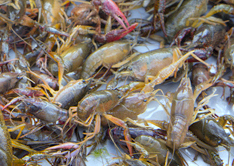Crawfish (Procambarus clarkii)
Common Names: Crayfish, crawdads, mudbugs

If you live the south chances are that you’ve been invited to a crawfish boil and eaten some delicious Louisiana mudbugs. Louisiana is the leading producer of crawfish, but Alabama, Mississippi, and Texas all have booming industries. Red swamp crawfish and white river crawfish are the two most commonly cultured species in the country and they are typically found in and are grown in the same ponds. Both species are successful in commercial, low-energy-input, extensive aquaculture systems because they are hardy and adaptable creatures whose life cycles can be easily manipulated to fit culture practices. Together, the two species make up over 90% of the total crawfish cultured in the US, with red swamp crawfish, the more desirable product, typically comprising 70-80% of the total catch.
Range: The red swamp crawfish is native to states bordering the Gulf of Mexico from Texas to Alabama and northwards up the Mississippi river to Tennessee and Illinois. It has been introduced in other states including Hawaii, and 19 other countries around the world.
Description: Red swamp crawfish may be distinguished from white river crawfish by several characteristics. In red swamp crawfish the two halves of the carapace meet and form a thin line and there is a pigmented “vein” on the underside of the tail. Crafwish have a red, or deep maroon carapace made of chitin.
Biology and Life History: Crawfish eat almost any plant material, preferring fresh, tender vegetation but readily consuming decaying plants for the microorganisms and invertebrates associated with decomposition. Crawfish are found in a variety of habitats, typically preferring areas with cover, such as rocks or dense vegetation and rarely surface, normally occupying only the bottom portions of the lake, pond, or stream. Mating typically peaks from May through June in the Deep South and peak spawning occurs in autumn to coincide with annual fall flood cycles and exhibits several waves of young emerging from burrows, resulting in a crawfish population of mixed sizes and age classes. Crawfish have adapted to deal with annual flood cycles by growing and maturing during the wet period and digging burrows in the dry periods to survive.
Stocking: It is common to stock 50-100 pounds of crawfish per acre of pond bottom area. New stockings should occur between April and July.
Cooking Crawfish: When selecting crawfish for cooking purposes make sure they are alive. Most crawfish are marketed live in sacks. Dependent on the number of mouths you have to feed, 1 to 2 pounds per person should be adequate, unless you have some crawfish lovers, then 3-6 pounds per person should be adequate. Store crawfish in a cooler while still in the sack over ice. Make sure the cooler drain is open to let out excess water. When you are ready to cook, rinse your crawfish with water to remove excess mud and detritus. Purging is unnecessary but if you choose to do so, soak crawfish in salt water for 5-10 minutes and rinse. Get a large pot and a propane burner and fill halfway. Add the seasoning of your choice, garlic cloves and fresh squeezed lemon juice and the residual lemon halves to the pot after water comes to a boil. Add crawfish and boil for two minutes. Turn off the heat and then let the crawfish soak for 8-10 minutes. Drain water and pour crawfish into a cooler until you are ready to serve.
Adapted From:
Crawfish production manual Texas A&M Agrilife Extension
http://www.sepond.com/Craw.html
http://www.thefishsite.com/articles/836/crawfish-stocking-the-facts
